How Can the Layout of Public Service Facilities Be Optimized to Reduce Travel-Related Carbon Emissions? Evidence from Changxing County, China
Abstract
:1. Introduction
2. Methodology
2.1. Methodological Framework
2.2. Step 1: Calculation of Travel-Related Carbon Dioxide Emissions
2.3. Step 2: Low-Carbon Layout Planning of Public Service Facilities
2.4. Processes of Optimization
3. Study Area and Datasets
3.1. Study Area
3.2. Datasets
4. Results
4.1. Changes in the Locations of Medical Facilities
4.2. Changes in the Quantitative Structure of Carbon Emissions
4.3. Changes in the Spatial Distribution of Carbon Emissions
4.4. Changes in Travel-Related Carbon Reduction Potential
5. Conclusions and Discussion
Author Contributions
Funding
Conflicts of Interest
Appendix A
| Criteria | Traffic Convenience | Urban Development Level | Population Distribution | Distance from Flammable and Explosive Sites | |||
|---|---|---|---|---|---|---|---|
| Evaluation Indicators | Accessibility | Distance from All Levels of Roads | Town Level | Population Density | Distance from Refueling Stations | Distance from Chemical Companies | Distance from Fireworks Distribution |
| Value | Criteria | Criteria | Criteria | Criteria | Criteria | Criteria | Criteria |
| 5 | 24.79~30.87 min | distance to national and provincial roads ≤ 500 m or distance to county road and village road ≤ 300 m or distance to town road ≤ 250 m or distance to county center road ≤ 200 m | Central area of county: Zhicheng Town, Huaxi Town, Longshan Town, Taihu Town | >30,000 person/km2 | >3000 m | >5000 m | >3000 m |
| 4 | 30.87~36.95 min | distance to national and provincial roads 500 m~1500 m or distance to county road and village road 300~900 m or distance to town road 250~500 m or distance to county center road 200~400 m | Level 2 township: Si’an Town | 10,000–30,000 person/km2 | 1000–3000 m | 4000–5000 m | 1000–3000 m |
| 3 | 36.95~43.02 min | distance to national and provincial roads 3000~5000 m or distance to county road and village road 1500~3000 m or distance to town road 1000~1500 m or distance to county center road 800~1200 m | Level 3 township: Meishan Town, Heping Town | 5000–10,000 person/km2 | 500–1000 m | 3000–4000 m | 500–1000 m |
| 2 | 43.02~49.10 min | distance to national and provincial roads 3000~5000 m or distance to county road and village road 1500~3000 m or distance to town road or distance to county center road 800~1200 m | Ordinary town | 1500–5000 person/km2 | 300–500 m | 2000–3000 m | 300–500 m |
| 1 | 49.10~55.17 min | distance to national and provincial roads > 5000 m or distance to county road and village road > 3000 m or distance to town road > 1500 m or distance to county center road > 1200 m | others | ≤1500 person/km2 | 50–300 m | 1000–2000 m | 100–300 m |
| 0 | / | / | / | / | ≤50 m | ≤1000 m | ≤100 m |
References
- Gautam, S.; Patra, A.K.; Kumar, P. Status and chemical characteristics of ambient PM2.5 pollutions in China: A review. Environ. Dev. Sustain. 2019, 21, 1649–1674. [Google Scholar]
- Gautam, S.; Yadav, A.; Tsai, C.J.; Kumar, P. A review on recent progress in observations, sources, classification and regulations of PM2.5 in Asian environments. Environ. Sci. Pollut. Res. 2016, 23, 21165–21175. Available online: https://ifbic1b13095ec5284139sqvkvoonx9nbk6wpqfiac.eds.tju.edu.cn/10.1007/s11356-016-7515-2 (accessed on 13 July 2022). [CrossRef] [PubMed]
- Alshqaqeeq, F.; Amin Esmaeili, M.; Overcash, M.; Twomey, J. Quantifying hospital services by carbon footprint: A systematic literature review of patient care alternatives. Resour. Conserv. Recycl. 2020, 154, 104560. [Google Scholar] [CrossRef]
- Walmsley, M.R.W.; Walmsley, T.G.; Atkins, M.J.; Kamp, P.J.J.; Neale, J.R.; Chand, A. Carbon emissions pinch analysis for emissions reductions in the New Zealand transport sector through to 2050. Energy 2015, 92, 569–576. [Google Scholar] [CrossRef]
- International Energy Agency (IEA). CO2 Emissions from Fuel Combustion; IEA: Paris, France, 2019; Available online: https://www.iea.org/reports/co2-emissions-from-fuel-combustion-2019 (accessed on 25 June 2021).
- Hankey, S.; Marshall, J.D. Impacts of urban form on future US passenger-vehicle greenhouse gas emissions. Energy Policy 2010, 38, 4880–4887. [Google Scholar] [CrossRef]
- Anderson, W.P.; Kanaroglou, P.S.; Miller, E.J. Urban Form, Energy and the Environment: A Review of Issues, Evidence and Policy. Urban Stud. 1996, 33, 7–35. [Google Scholar] [CrossRef]
- Geurs, K.T.; van Wee, B. Accessibility evaluation of land-use and transport strategies: Review and research directions. J. Transp. Geogr. 2004, 12, 127–140. [Google Scholar] [CrossRef]
- Næss, P. Urban form and travel behavior: Experience from a Nordic context. J. Transp. Land Use 2012, 5, 21–45. [Google Scholar] [CrossRef]
- Dajani, J.S. Cost Studies of Urban Public Services. Land Econ. 1973, 49, 479. [Google Scholar] [CrossRef]
- Zahabi, S.A.H.; Miranda-Moreno, L.; Patterson, Z.; Barla, P.; Harding, C. Transportation Greenhouse Gas Emissions and its Relationship with Urban Form, Transit Accessibility and Emerging Green Technologies: A Montreal Case Study. Procedia-Soc. Behav. Sci. 2012, 54, 966–978. [Google Scholar] [CrossRef] [Green Version]
- Ma, J.; Zhou, S.; Mitchell, G.; Zhang, J. CO2 emission from passenger travel in Guangzhou, China: A small area simulation. Appl. Geogr. 2018, 98, 121–132. [Google Scholar] [CrossRef]
- Papa, E.; Bertolini, L. Accessibility and Transit-Oriented Development in European metropolitan areas. J. Transp. Geogr. 2015, 47, 70–83. [Google Scholar] [CrossRef] [Green Version]
- Lahtinen, J.; Salonen, M.; Toivonen, T. Facility allocation strategies and the sustainability of service delivery: Modelling library patronage patterns and their related CO2-emissions. Appl. Geogr. 2013, 44, 43–52. [Google Scholar] [CrossRef]
- Wang, W.; Zhou, Z.H.; Chen, J.; Cheng, W.; Chen, J. Analysis of Location Selection of Public Service Facilities Based on Urban Land Accessibility. Int. J. Environ. Res. Public Health 2021, 18, 516. [Google Scholar] [CrossRef]
- Li, J.; Lo, K.; Zhang, P.; Guo, M. Consumer travel behaviors and transport carbon emissions: A comparative study of commercial centers in Shenyang, China. Energies 2016, 9, 765. [Google Scholar] [CrossRef] [Green Version]
- Zhang, R.; Matsushima, K.; Kobayashi, K. Can land use planning help mitigate transport-related carbon emissions? A case of Changzhou. Land Use Policy 2018, 74, 32–40. [Google Scholar] [CrossRef]
- Tang, X.F.; Zhang, J.; Xu, P. A multi-objective optimization model for sustainable logistics facility location. Transp. Res. Part D Transp. Environ. 2013, 22, 45–48. [Google Scholar] [CrossRef]
- Hwang, T.; Lee, M.; Lee, C.; Kang, S. Meta-heuristic approach for high-demand facility locations considering traffic congestion and greenhouse gas emission. J. Environ. Eng. Landsc. Manag. 2016, 24, 233–244. [Google Scholar] [CrossRef] [Green Version]
- Liu, Z.; Ma, J.; Chai, Y. Neighbourhood-scale urban form, travel behaviour, and CO2 emissions in Beijing: Implications for low-carbon urban planning. Urban Geogr. 2017, 38, 381–400. [Google Scholar] [CrossRef]
- Jarass, J.; Scheiner, J. Residential self-selection and travel mode use in a new inner-city development neighbourhood in Berlin. J. Transp. Geogr. 2018, 70, 68–77. [Google Scholar] [CrossRef]
- Neutens, T.; Delafontaine, M.; Scott, D.M.; De Maeyer, P. A GIS-based method to identify spatiotemporal gaps in public service delivery. Appl. Geogr. 2012, 32, 253–264. [Google Scholar] [CrossRef] [Green Version]
- Tao, Z.L.; Cheng, Y.; Dai, T.Q.; Rosenberg, M.W. Spatial Optimization of Residential Care Facility Locations in Beijing, China: Maximum Equity in Accessibility. Int. J. Health Geogr. 2014, 13, 33. [Google Scholar] [CrossRef] [PubMed] [Green Version]
- Lira-Barragán, L.F.; Ponce-Ortega, J.M.; Serna-González, M.; El-Halwagi, M.M. An MINLP model for the optimal location of a new industrial plant with simultaneous consideration of economic and environmental criteria. Ind. Eng. Chem. Res. 2011, 50, 953–964. [Google Scholar] [CrossRef]
- Church, R.L.; Scaparra, M.P.; Middleton, R.S. Identifying critical infrastructure: The median and covering facility interdiction problems. Ann. Assoc. Am. Geogr. 2004, 94, 491–502. [Google Scholar] [CrossRef]
- Tao, Z.L.; Zheng, Q.; Kong, H. A Modified Gravity p-Median Model for Optimizing Facility Locations. J. Syst. Sci. Inf. 2019, 6, 421–434. [Google Scholar] [CrossRef]
- Wei, X.; Quan, T. The low-carbon influencing mechanism of spatial characteristic parameters in China’s residential communities. J. Asian Archit. Build. Eng. 2021, 20, 88–100. [Google Scholar] [CrossRef]
- Chen, L.J.; Olhager, J.; Tang, O. Manufacturing facility location and sustainability: A literature review and research agenda. Int. J. Prod. Econ. 2014, 149, 154–163. [Google Scholar] [CrossRef] [Green Version]
- Tao, Z.L.; Cheng, Y.; Dai, T.Q.; Zheng, Q.J. Research progress and prospect of public service facilities layout optimization models. City Plan Rev. 2019, 43, 60–68. [Google Scholar] [CrossRef]
- Fadda, E.; Manerba, D.; Cabodi, G.; Camurati, P.E.; Tadei, R. Comparative analysis of models and performance indicators for optimal service facility location. Transp. Res. Part E Logist. Transp. Rev. 2021, 145, 102174. [Google Scholar] [CrossRef]
- Dai, H.; Mischke, P.; Xie, X.; Xie, Y.; Masui, T. Closing the gap? Top-down versus bottom-up projections of China’s regional energy use and CO2 emissions. Appl. Energy 2016, 162, 1355–1373. [Google Scholar] [CrossRef]
- Selvakkumaran, S.; Limmeechokchai, B. Low carbon society scenario analysis of transport sector of an emerging economy—The aim/enduse modelling approach. Energy Policy 2015, 81, 199–214. [Google Scholar] [CrossRef]
- IPCC. 2006 IPCC Guidelines for National Greenhouse Gas Inventories. 2006. Available online: https://www.ipcc-nggip.iges.or.jp/public/2006gl/chinese/index.html (accessed on 8 December 2020).
- Wang, Z.; Chen, F.; Fujiyama, T. Carbon emission from urban passenger transportation in Beijing. Transp. Res. Part D Transp. Environ. 2015, 41, 217–227. [Google Scholar] [CrossRef]
- Tichavska, M.; Tovar, B. Environmental cost and eco-efficiency from vessel emissions in Las Palmas Port. Transp. Res. Part E Logist. Transp. Rev. 2015, 83, 126–140. [Google Scholar] [CrossRef]
- Zeng, Y.; Tan, X.; Gu, B.; Wang, Y.; Xu, B. Greenhouse gas emissions of motor vehicles in Chinese cities and the implication for China’s mitigation targets. Appl. Energy 2016, 184, 1016–1025. [Google Scholar] [CrossRef]
- Ma, J.; Heppenstall, A.; Harland, K.; Mitchell, G. Synthesising carbon emission for mega-cities: A static spatial microsimulation of transport CO2 from urban travel in Beijing. Comput. Environ. Urban Syst. 2014, 45, 78–88. [Google Scholar] [CrossRef]
- Howitt, O.J.; Revol, V.G.; Smith, I.J.; Rodger, C.J. Carbon emissions from international cruise ship passengers’ travel to and from New Zealand. Energy Policy 2010, 38, 2552–2560. [Google Scholar] [CrossRef]
- Huang, D.; Yu, J.; Shen, S.; Li, Z.; Zhao, L.; Gong, C. A Method for Bus OD Matrix Estimation Using Multisource Data. J. Adv. Transp. 2020, 2020, 5740521. [Google Scholar] [CrossRef]
- Mokhtarian, P.L.; Cao, X. Examining the impacts of residential self-selection on travel behavior: A focus on methodologies. Transp. Res. Part B Methodol. 2008, 42, 204–228. [Google Scholar] [CrossRef] [Green Version]
- Cao, X.; Mokhtarian, P.L.; Handy, S.L. Examining the impacts of residential self-selection on travel behaviour: A focus on empirical findings. Transp. Rev. 2009, 29, 359–395. [Google Scholar] [CrossRef]
- Huff, D.L.; Parameter Estimation in the Huff Model. ArcUser. 2003, Volume 3. Available online: www.esri.com (accessed on 10 October 2019).
- Peeters, D.; Thomas, I. Distance predicting functions and applied location-allocation models. J. Geogr. Syst. 2000, 2, 167–184. [Google Scholar] [CrossRef]
- Hakimi, S.L. Optimum locations of switching centers and the absolute centers and medians of a graph. Oper. Res. 1964, 12, 450–459. [Google Scholar] [CrossRef]
- Zaferanieh, M.; Abareshi, M.; Fathali, J. The minimum information approach to the uncapacitated p-median facility location problem. Transp. Lett. 2022, 14, 307–316. [Google Scholar] [CrossRef]
- Klose, A.; Drexl, A. Facility location models for distribution system design. Eur. J. Oper. Res. 2005, 162, 4–29. [Google Scholar] [CrossRef] [Green Version]
- Møller-Jensen, L.; Kofie, R.Y. Exploiting available data sources: Location/allocation modeling for health service planning in rural Ghana. Geogr. Tidsskr. 2001, 101, 145–153. [Google Scholar] [CrossRef]
- Asadi-Shekari, Z.; Moeinaddini, M.; Zaly Shah, M. A pedestrian level of service method for evaluating and promoting walking facilities on campus streets. Land Use Policy 2014, 38, 175–193. [Google Scholar] [CrossRef]
- Gan, J.; Li, L.; Xiang, Q.; Ran, B. A prediction method of GHG emissions for urban road transportation planning and its applications. Sustainability 2020, 12, 10251. [Google Scholar] [CrossRef]
- Liu, H.; Yan, F.; Tian, H. A vector map of carbon emission based on point-line-area carbon emission classified allocation method. Sustainability 2020, 12, 10058. [Google Scholar] [CrossRef]
- Chai, Y.W.; Xiao, Z.P.; Liu, Z.L. Comparative Analysis on CO2 Emission Per Household in Daily Travel Based on Spatial Behavior Constraints. Sci. Geogr. Sinica 2011, 31, 843–849. [Google Scholar] [CrossRef]
- Lee, A.H.I.; Kang, H.Y.; Hsu, C.F.; Hung, H.C. A green supplier selection model for high-tech industry. Expert Syst. Appl. 2009, 36, 7917–7927. [Google Scholar] [CrossRef]
- He, X.H.; Cao, Z.C.; Zhang, S.L.; Liang, S.M.; Zhang, Y.Y.; Ji, T.B.; Shi, Q. Coordination Investigation of the Economic, Social and Environmental Benefits of Urban Public Transport Infrastructure in 13 Cities, Jiangsu Province, China. Int. J. Environ. Res. Public Health 2020, 17, 6809. [Google Scholar] [CrossRef] [PubMed]
- Garcia-Sierra, M.; van den Bergh, J.C.J.M.; Miralles-Guasch, C. Behavioural economics, travel behaviour and environmental-transport policy. Transp. Res. Part D Transp. Environ. 2015, 41, 288–305. [Google Scholar] [CrossRef]
- Cao, X.; Yang, W. Examining the effects of the built environment and residential self-selection on commuting trips and the related CO2 emissions: An empirical study in Guangzhou, China. Transp. Res. Part D Transp. Environ. 2017, 52, 480–494. [Google Scholar] [CrossRef]
- Shi, Y.; Yang, J.; Shen, P. Revealing the Correlation between Population Density and the Spatial Distribution of Urban Public Service Facilities with Mobile Phone Data. ISPRS Int. J. Geo-Inf. 2020, 9, 38. [Google Scholar] [CrossRef] [Green Version]
- Van Acker, V.; Witlox, F. Car ownership as a mediating variable in car travel behaviour research using a structural eq-uation modelling approach to identify its dual relationship. J. Transp. Geogr. 2010, 18, 65–74. [Google Scholar] [CrossRef] [Green Version]
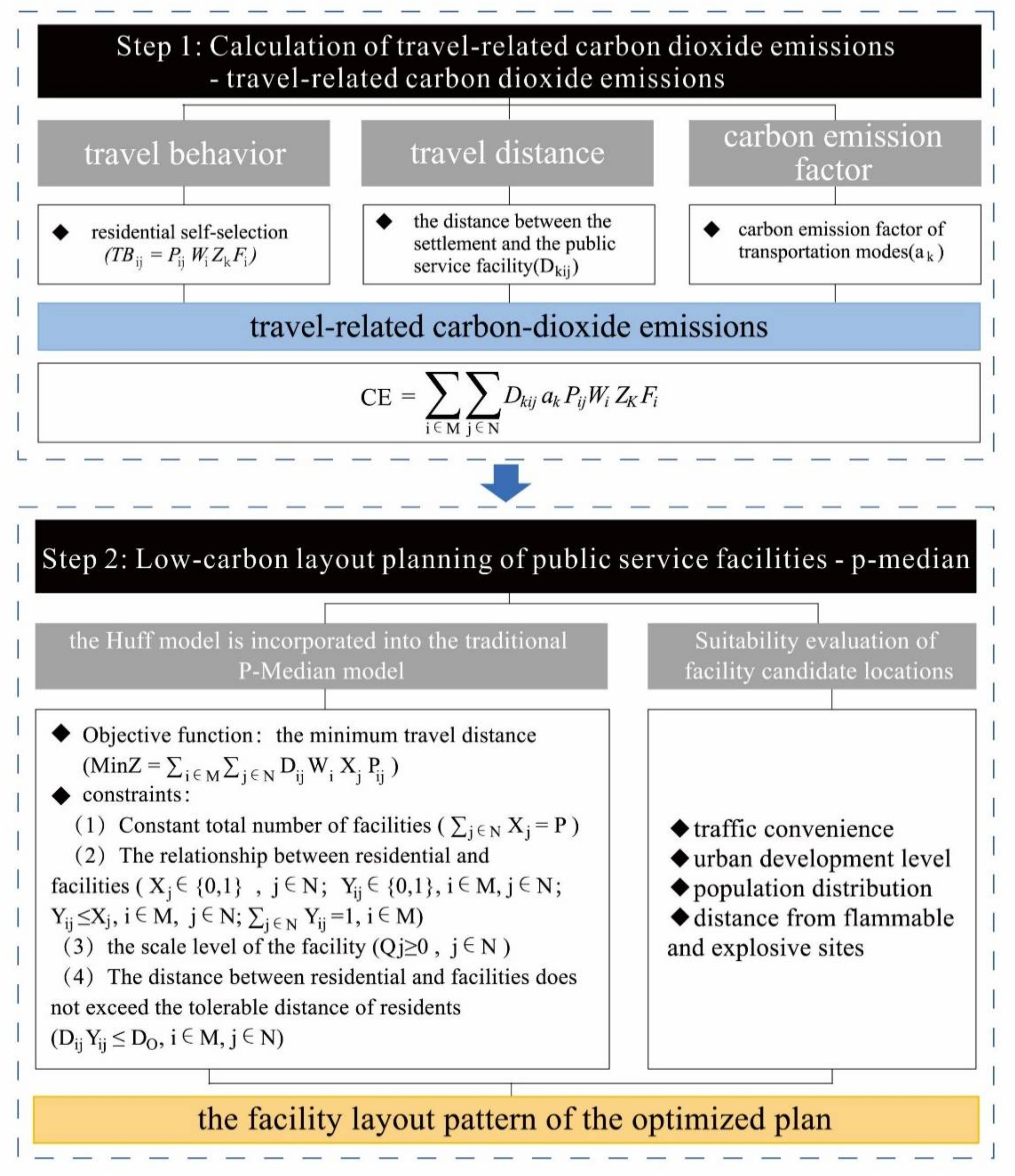
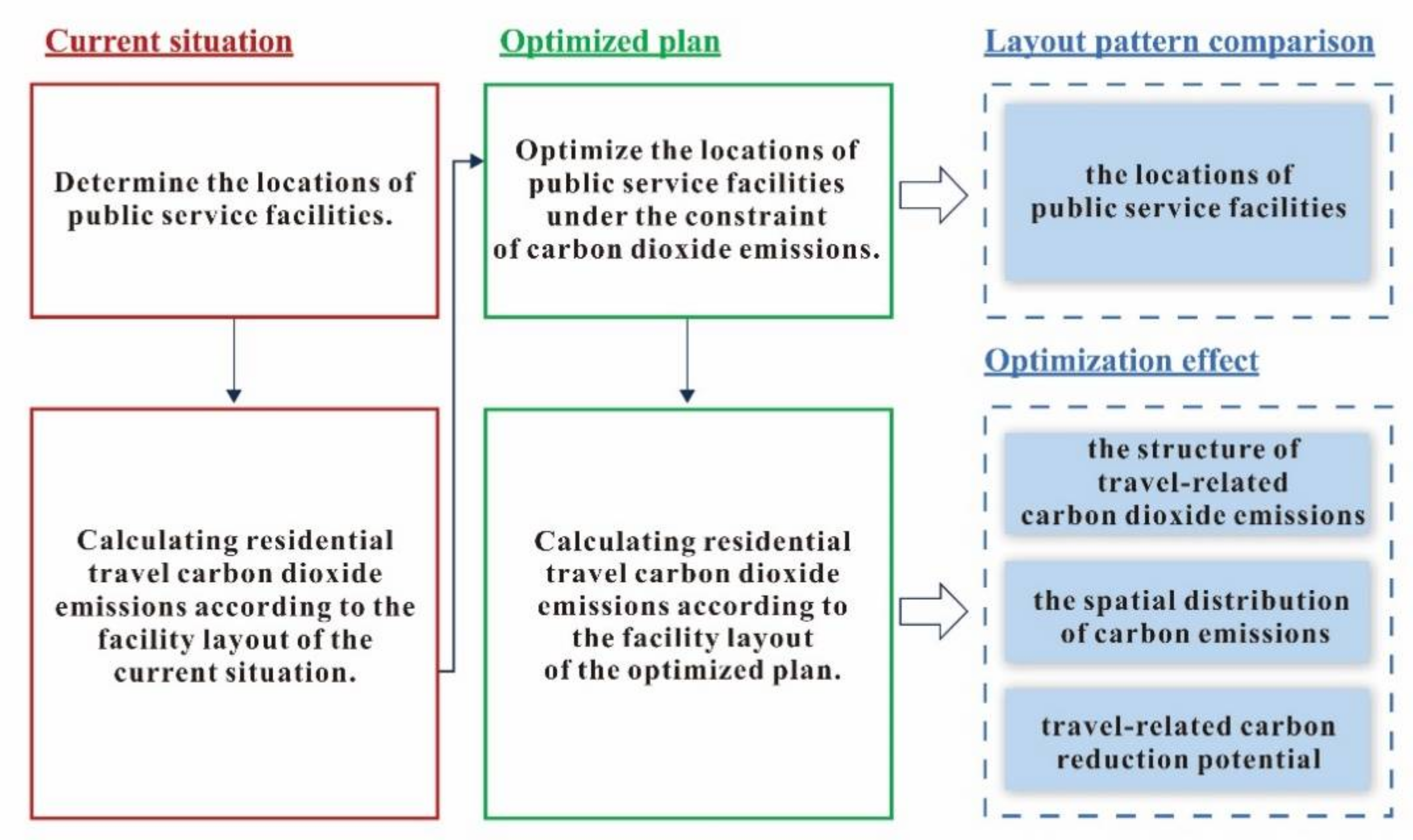
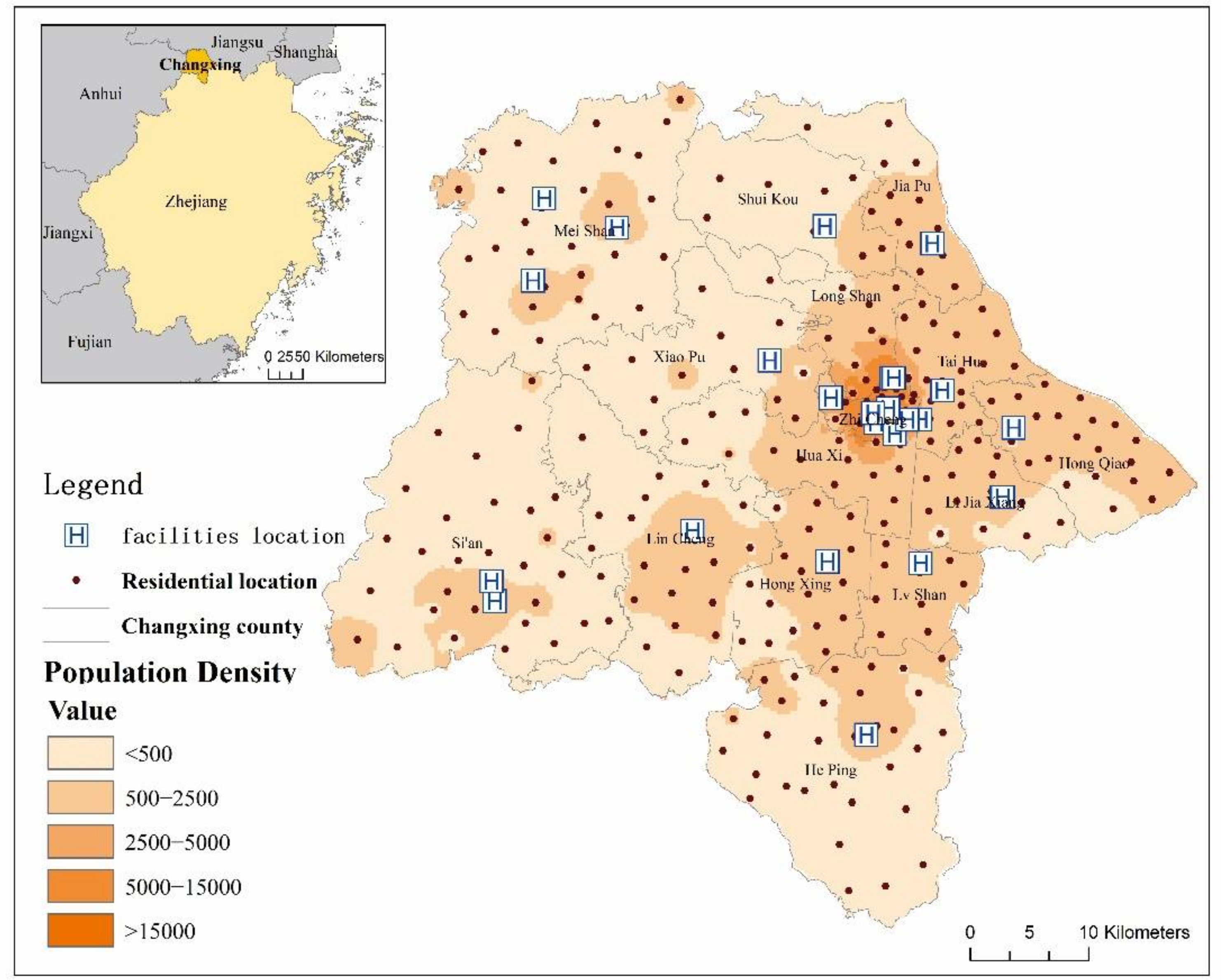
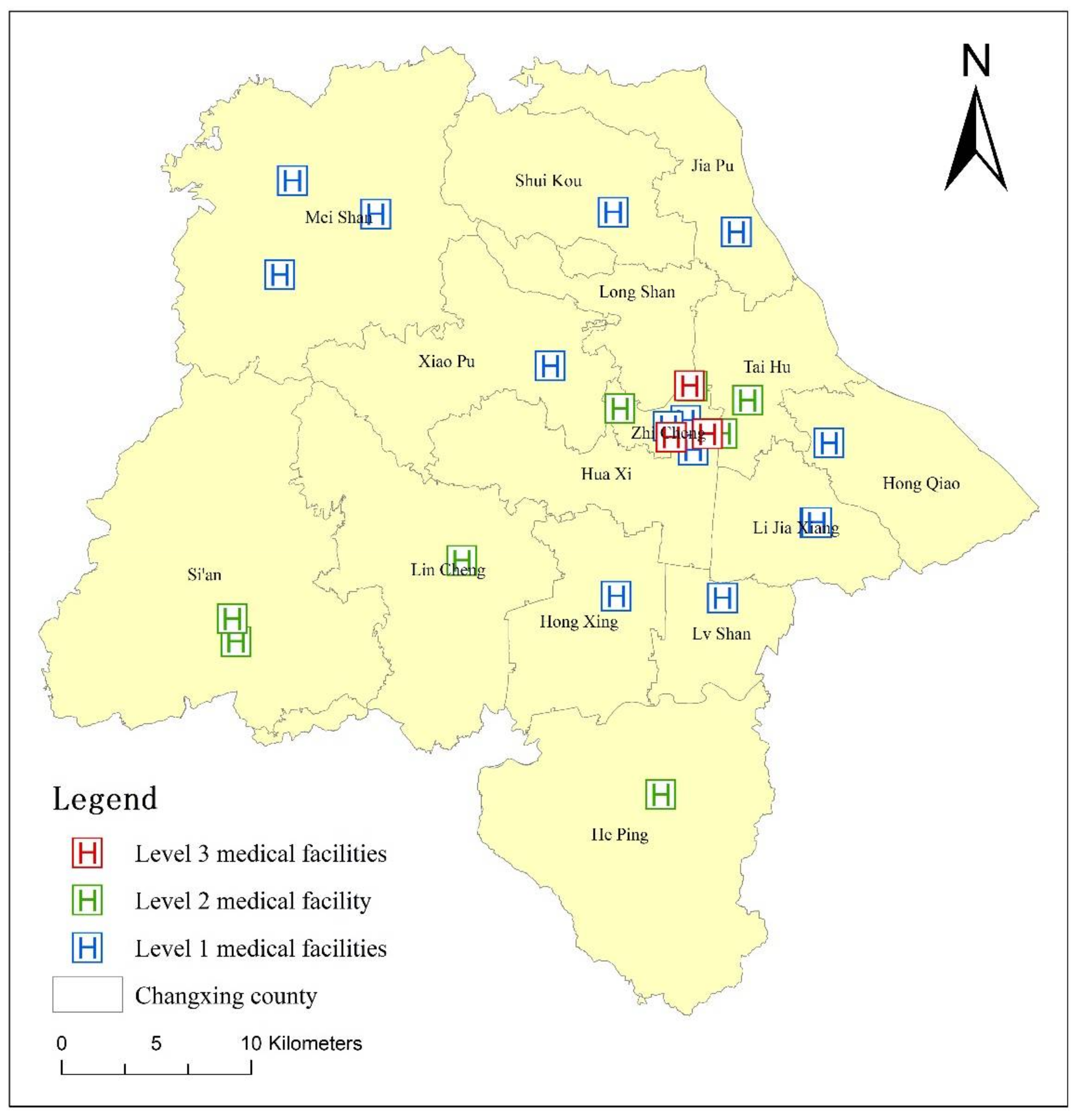

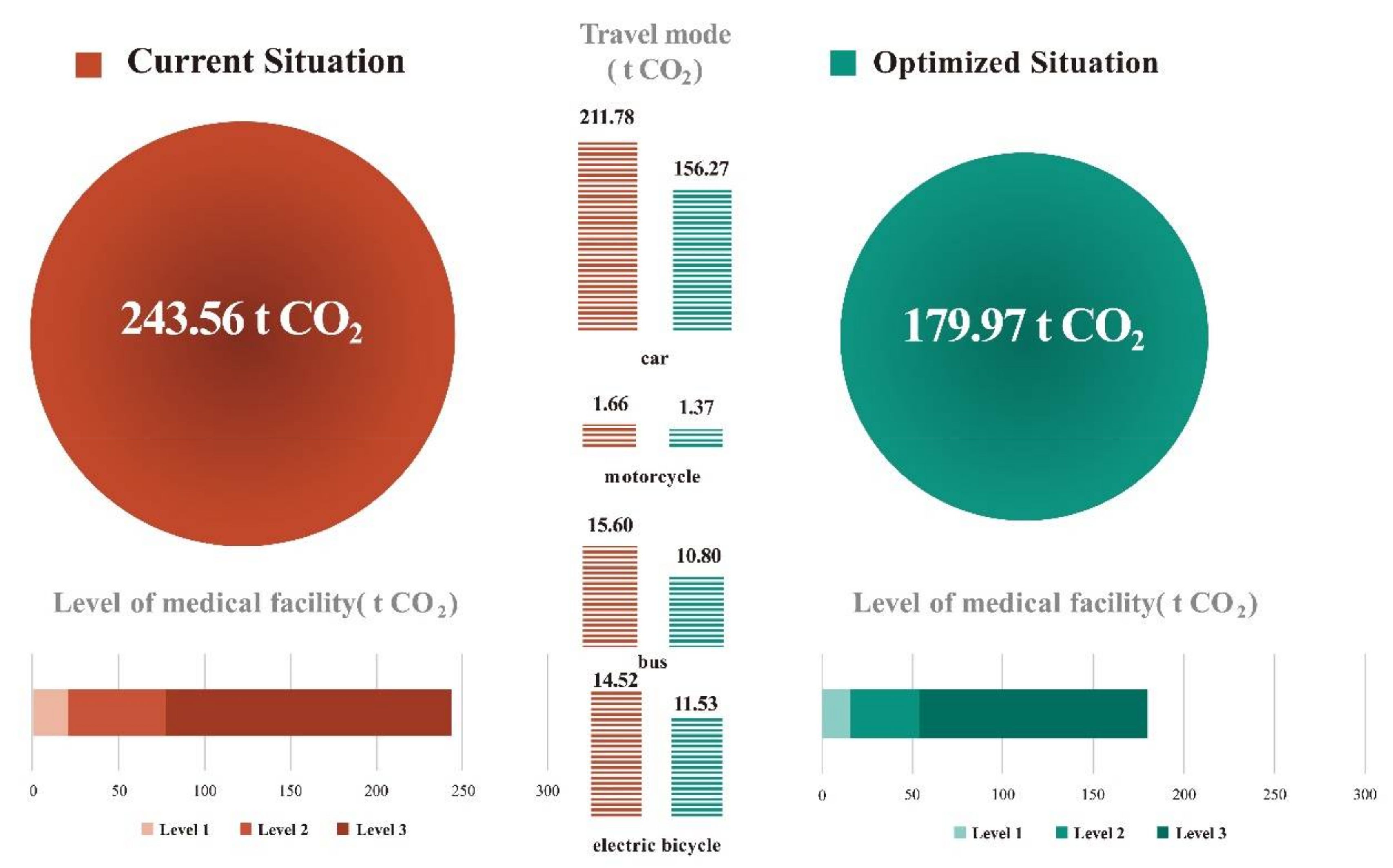

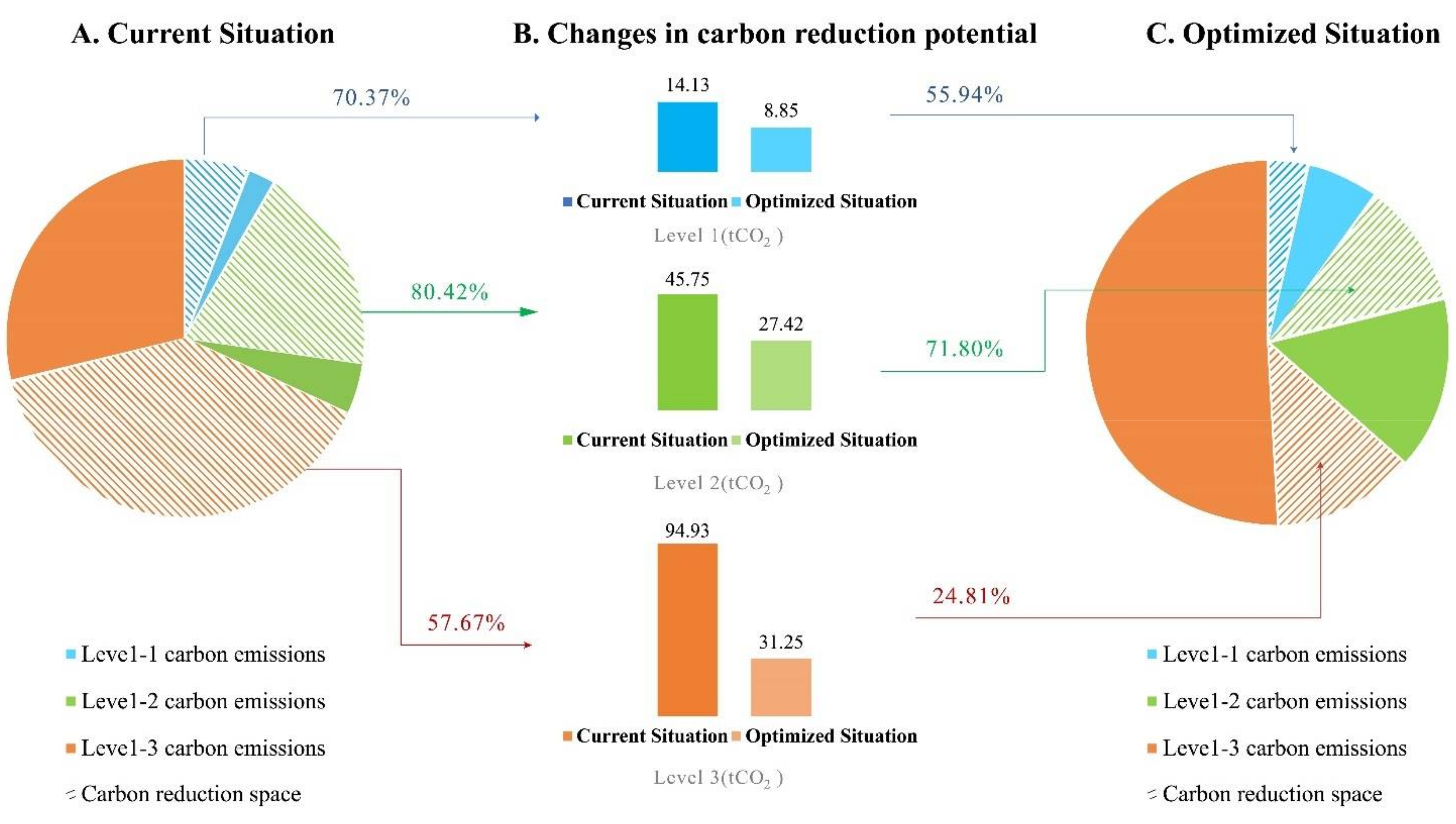
| Study Area (Place) | Pollutant Types | Key Observations | Author (Year) |
|---|---|---|---|
| Montreal, Canada | transportation greenhouse gas emissions | For every 10% increase in the accessibility of public service facilities in the built environment, there was a corresponding 5.8% reduction in transportation greenhouse gases. | [11] Zahabi et al. (2012) |
| Guangzhou, China | travel-related CO2 emissions | Poorer accessibility of public service facilities in remote urban areas or newly developed urban areas usually generates more travel-related carbon emissions. | [12] Ma et al. (2018) |
| Helsinki, Finnish | travel-related CO2 emissions | They estimated the travel carbon emissions generated by residents arriving at libraries in the Finnish capital region. | [14] Lahtinen et al. (2013) |
| Four typical counties in China | travel-related CO2 emissions | They calculated the carbon emissions of educational and medical-facility-related trips. | [15] Wang et al. (2021) |
| Shenyang, China | travel-related CO2 emissions | They measured the travel carbon emissions generated by consumers’ travel to commercial centers of different levels in the city of Shenyang. | [16] Li et al. (2016) |
| Changzhou, China | transport-related carbon emissions | Land-use planning can help mitigate transport-related carbon emissions | [17] Zhang et al. (2018) |
| China | CO2 emissions from transport activities | They proposed a multi-objective optimization model based on the classic facility location problem, which maximizes the reliability of services and minimizes CO2 emissions from transport activities. | [18] Tang et al. (2013) |
| Incheon, Republic of Korea | vehicle emissions | They proposed a new location model for high-demand facilities in urban areas with incorporation of the traffic congestion and greenhouse gas emissions costs. | [19] Hwang et al. (2016) |
| Type | Subtype | Value | Source | ||
|---|---|---|---|---|---|
| Travel behavior | Facility level | Level 1 | Level 2 | Level 3 | |
| Tolerance time (min) | 12 | 12 | 25 | The average of the questionnaire results | |
| Tolerance distance (km) | 9.66 | 4.48 | 4.48 | The calculation of the road traffic network datasets | |
| Frequency of travel (times/month) | 0.44 | 0.44 | 0.6 | Questionnaire | |
| Population of residential (104) | 63.32 | Changxing Public Security Bureau | |||
| Spatial data | Locations of medical facilities | 25 medical facilities | https://www.metrodata.cn/ (accessed on 3 March 2020) | ||
| Locations of residentials | 277 residentials | Changxing Construction Bureau | |||
| Road Average speed (km/h) | highway | 80 | Changxing Transportation Bureau | ||
| national road | 45 | ||||
| provincial road | 40 | ||||
| county/township road | 45 | ||||
| county center main road | 15 | ||||
| county center submain road | 15 | ||||
| town road | 25 | ||||
| village road | 35 | ||||
| Carbon emission factor | car | 135 g CO2/person-km | [51] Chai et al., 2011 | ||
| bus | 35 g CO2/person-km | [51] Chai et al., 2011 | |||
| motorcycle | 113.6 g CO2/person-km | TREMOVE model * | |||
| electric bicycle | 28.14 g CO2/person-km | The results of this paper | |||
| Evaluation Criteria | Traffic Convenience | Urban Development Level | Population Distribution | Distance from Flammable and Explosive Sites | |||
|---|---|---|---|---|---|---|---|
| Evaluation Indicators | Accessibility | Distance from All Levels of Roads | Town System Level | Population Density | Distance from Refueling Stations | Distance from Chemical Companies | Distance from Fireworks Distribution |
| AHP | 0.3317 | 0.0594 | 0.1229 | 0.4421 | 0.0212 | 0.0199 | 0.0028 |
| Entropy method | 0.0113 | 0.0462 | 0.1422 | 0.6436 | 0.1323 | 0.0127 | 0.0117 |
| Combination | 0.2738 | 0.0752 | 0.1833 | 0.7376 | 0.0955 | 0.0235 | 0.0092 |
| Factors | Variable | Indicator Items |
|---|---|---|
| Health technical personnel | X1 | Number of practicing physicians |
| X2 | Number of practicing assistant physicians | |
| X3 | Number of registered nurses | |
| X4 | Number of pharmaceutical personnel | |
| X5 | Number of inspectors | |
| X6 | Number of imaging staff | |
| X7 | Number of other health technicians | |
| Medical equipment | X8 | Number of beds |
| X9 | Number of managers | |
| Availability of diagnosis and treatment services | X10 | Total number of patients |
| X11 | Number of discharged patients |
| Serial Number | Hospital Name | Service Capacity Composite Score | Grade Delineation |
|---|---|---|---|
| 1 | Changxing People’s Hospital | 10,001.000 | 3 |
| 2 | Changxing Hospital of Traditional Chinese Medicine | 5998.897 | 3 |
| 3 | Medical Health Group Changxing Hospital | 3046.554 | 3 |
| 4 | Changxing Maternal and Child Health Center | 2985.480 | 2 |
| 5 | Changxing Guotai Rehabilitation Hospital | 2527.579 | 2 |
| 6 | Urban community health centers | 2204.076 | 2 |
| 7 | Siuan Township Health Center | 1934.307 | 2 |
| 8 | Changxing Second Hospital | 1856.652 | 2 |
| 9 | Peace Town Health Center | 1773.256 | 2 |
| 10 | Lincheng Health Center | 1621.701 | 2 |
| 11 | Changxing Pheasant State Hospital | 1589.449 | 2 |
| 12 | Jipu Town Health Center | 1165.906 | 1 |
| 13 | Painted Brook Street Health Service Center | 1013.162 | 1 |
| 14 | Hongxingqiao Town Health Center | 1011.859 | 1 |
| 15 | Xiaopu Town Health Center | 616.592 | 1 |
| 16 | Lijiaxiang Town Health Center | 587.295 | 1 |
| 17 | Shuikou Township Health Center | 506.829 | 1 |
| 18 | Lushan Township Health Center | 489.776 | 1 |
| 19 | Hongqiao Township Health Center | 432.515 | 1 |
| 20 | Meishan Township Health Center | 377.918 | 1 |
| 21 | Baekhyan Health Center | 363.325 | 1 |
| 22 | Changxing Minfu Hospital of Traditional Chinese Medicine | 306.782 | 1 |
| 23 | Sopoikan Health Center | 298.035 | 1 |
| 24 | Lee’s Lane Rehabilitation and Care Hospital | 211.679 | 1 |
| 25 | Sanshi Cement Company Staff Hospital | 57.767 | 1 |
| Per Capita Travel Carbon Emissions by Class | Monthly Average CO2 (kg/Person) | Rate of Reduction in Per Capita CO2 | |
|---|---|---|---|
| Average travel carbon emissions from visits to level 1 medical facilities | current situation | 0.095 | 22.14% |
| optimized plan | 0.074 | ||
| Average travel carbon emissions from visits to level 2 medical facilities | current situation | 0.032 | 32.33% |
| optimized plan | 0.022 | ||
| Average travel carbon emissions from visits level 3 medical facilities | current situation | 0.012 | 16.76% |
| optimized plan | 0.010 | ||
Publisher’s Note: MDPI stays neutral with regard to jurisdictional claims in published maps and institutional affiliations. |
© 2022 by the authors. Licensee MDPI, Basel, Switzerland. This article is an open access article distributed under the terms and conditions of the Creative Commons Attribution (CC BY) license (https://creativecommons.org/licenses/by/4.0/).
Share and Cite
Yan, F.; Huang, N.; Zhang, Y. How Can the Layout of Public Service Facilities Be Optimized to Reduce Travel-Related Carbon Emissions? Evidence from Changxing County, China. Land 2022, 11, 1200. https://doi.org/10.3390/land11081200
Yan F, Huang N, Zhang Y. How Can the Layout of Public Service Facilities Be Optimized to Reduce Travel-Related Carbon Emissions? Evidence from Changxing County, China. Land. 2022; 11(8):1200. https://doi.org/10.3390/land11081200
Chicago/Turabian StyleYan, Fengying, Ningyu Huang, and Yehui Zhang. 2022. "How Can the Layout of Public Service Facilities Be Optimized to Reduce Travel-Related Carbon Emissions? Evidence from Changxing County, China" Land 11, no. 8: 1200. https://doi.org/10.3390/land11081200





